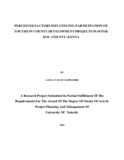Perceived Factors Influencing Participation Of Youths In County Development Projects In Sotik Sub –County, Kenya
| dc.contributor.author | Kipkorir, Langat J | |
| dc.date.accessioned | 2016-11-22T06:53:34Z | |
| dc.date.available | 2016-11-22T06:53:34Z | |
| dc.date.issued | 2016 | |
| dc.identifier.uri | http://hdl.handle.net/11295/97667 | |
| dc.description.abstract | The youth in Kenya are one of the major assets for the newly established county governments as they can contribute immensely towards enhancing governance not only at the county but also the national level. The challenge however is upon young people to mobilize and organize themselves in order to meaningfully participate in governance. Leaders at both the national and county level can on their part ensure youth engagement by creating a conducive environment that allows for young people’s participation. Contemporary development scholars have been advocating the inclusion of youth participation in development projects as they believe the avowed objectives of any project cannot be fully achieved unless people meaningfully participate in it. The purpose of the study is to investigate perceived factors influencing participation of youths in county development projects in Sotik Sub- County. This study is striving to determine how youths are involved in implementation of projects. The objectives of the study are: to evaluate institutional and regulatory framework; to assess youths decision making; to establish the capacity building and investigate the level of education in influencing youths participation in development projects in Sotik Sub- County. The study was based on the Arnstein’s (1969) theory of community participation and Ludwig’s theory of group functioning. Arnstein proposed a ladder of participation. Ludwig (1968) theorizes groups as systems. Groups are conceived as entities that reasonably can be differentiated from their environment and have some kind of boundaries across which interactions take place with the environment. The study targeted 1250 Youth group officials and 3750 Youth group members of all registered youths groups in Sotik Sub-County. Questionnaires was be used to obtain data from the participants. Descriptive survey design was used because it provided the real picture about the existing conditions without manipulating the variables. Stratified random sampling technique was adopted to select those who participated in the study. Descriptive statistics such as the frequencies and percentages was used to analyze quantitative data. The findings was presented using frequency distribution tables. | en_US |
| dc.language.iso | en | en_US |
| dc.publisher | University Of Nairobi | en_US |
| dc.rights | Attribution-NonCommercial-NoDerivs 3.0 United States | * |
| dc.rights.uri | http://creativecommons.org/licenses/by-nc-nd/3.0/us/ | * |
| dc.title | Perceived Factors Influencing Participation Of Youths In County Development Projects In Sotik Sub –County, Kenya | en_US |
| dc.type | Thesis | en_US |



